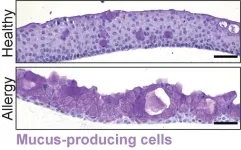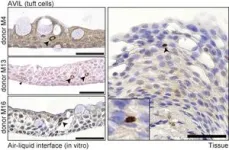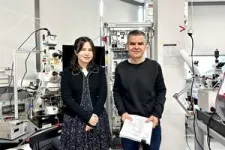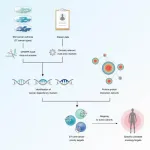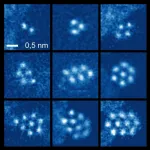(Press-News.org) The Organoid group at the Hubrecht Institute produced the first organoid model of the human conjunctiva. These organoids mimic the function of the actual human conjunctiva, a tissue involved in tear production. Using their new model, the researchers discovered a new cell type in this tissue: tuft cells. The tuft cells become more abundant under allergy-like conditions and are therefore likely to play a role in allergies. The organoid model can now be used to test drugs for several diseases affecting the conjunctiva. The study will be published in Cell Stem Cell on 11 January 2024.
Our eyes produce tears to protect themselves from injuries and infections. The conjunctiva, a tissue that covers the white of the eye and the inside of the eyelids, is partially responsible for the production of these tears. It participates in tear production through the release of mucus. This mucus allows the tears to stick to the ocular surface and protects it from pathogens.
Limited treatment options
Several diseases and disorders affect the conjunctiva, such as dry eye disease, cancer, allergies and infections. In severe cases, disfunction of this tissue can lead to blindness. Until now, there has not been a good model of the human conjunctiva, which limits research into its function in sickness and in health. Consequently, there are limited treatment options for diseases affecting the conjunctiva.
First model
To gain more insight into the composition and functioning of the conjunctiva, the Organoid group set out to develop the first human model of this type of tissue. They used cells from an actual human conjunctiva and grew them into 3D structures in a dish. These miniature structures are called organoids and function as real human conjunctiva. “Once we had these functioning organoids, we wanted to know how the conjunctiva is involved in the production of tears,” Marie Bannier-Hélaouët, lead researcher in the project, explains. “We discovered that the conjunctiva makes antimicrobial components and therefore contributes to tear production in more ways than by simply making mucus.”
Allergies
The researchers then altered the conditions in the dish with the miniature conjunctivae to mimic allergies. “The organoids started to produce completely different tears: there was more mucus but there were also more antimicrobial components,” says Bannier-Hélaouët. Under these conditions, they also found a new cell type in the organoids: tuft cells. Bannier-Hélaouët continues: “Similar cells have been discovered in other tissues, but not in the human conjunctiva.” The tuft cells became more abundant under the allergy-like conditions, suggesting they play a role in the eye’s reaction to allergies.
Drugs
The newly developed organoid model opens the door for research into diseases affecting the conjunctiva. “We can use our model to test drugs for allergies or dry eye disease, for example,” says Bannier-Hélaouët. In the long term, it may even be possible to make replacement conjunctivae for people with ocular burns, ocular cancers or maybe even genetic disorders. “We are now running preclinical studies in rabbits to assess whether this approach is feasible and helpful,” Bannier-Hélaouët concludes.
Publication
Human Conjunctiva Organoids to Study Ocular Surface Homeostasis and Disease. Marie Bannier-Hélaouët, Jeroen Korving, Ziliang Ma, Harry Begthel, Amir Giladi, Mart M. Lamers, Willine J. van de Wetering, Nobuyo Yawata, Makoto Yawata, Vanessa L. S. LaPointe, Mor M. Dickman, Rachel Kalmann, Saskia M. Imhoff, Johan H. van Es, Carmen López-Iglesias, Peter J. Peters, Bart L. Haagmans, Wei Wu and Hans Clevers. Cell Stem Cell, 2024.
******************************************************************************************************************************************************************************
About Hans Clevers
Hans Clevers is advisor/guest researcher at the Hubrecht Institute for Developmental Biology and Stem Cell Research (KNAW) and at the Princess Máxima Center for Pediatric Oncology. He holds a professorship in Molecular Genetics from the Utrecht University and is an Oncode Investigator. Hans Clevers has been the Head of Pharma Research and Early Development (pRED) at Roche since 2022. He previously held directorship/President positions at the Hubrecht Institute, the Royal Netherlands Academy of Arts and Sciences and the Princess Máxima Center for pediatric oncology.
About the Hubrecht Institute
The Hubrecht Institute is a research institute focused on developmental and stem cell biology. Because of the dynamic character of the research, the institute has a variable number of research groups, around 20, that do fundamental, multidisciplinary research on healthy and diseased cells, tissues and organisms. The Hubrecht Institute is a research institute of the Royal Netherlands Academy of Arts and Sciences (KNAW), situated on Utrecht Science Park. Since 2008, the institute is affiliated with the UMC Utrecht, advancing the translation of research to the clinic. The Hubrecht Institute has a partnership with the European Molecular Biology Laboratory (EMBL). For more information, visit www.hubrecht.eu.
END
Producing tears in a dish: researchers develop first model of human conjunctiva
2024-01-11
ELSE PRESS RELEASES FROM THIS DATE:
Palaeontology: New dinosaur species may be closest known relative of Tyrannosaurus rex
2024-01-11
A new species of tyrannosaur from southern North America that may the closest known relative of Tyrannosaurus rex is described in a study published in Scientific Reports.
Sebastian Dalman and colleagues identified the new species — which they have named Tyrannosaurus mcraeensis — by examining a fossilised partial skull, which was previously discovered in the Hall Lake Formation, New Mexico, USA. Although these remains were initially assigned to T. rex and are comparable in size to those of T. rex (which was up to 12 metres long), the authors propose that they belong to a new species due ...
Research shows deadly brain cancer can mimic healthy neurons
2024-01-11
MIAMI, FLORIDA (EMBARGOED UNTIL JAN. 11, 2024, at 11 AM EST) – Certain cancers are more difficult to treat because they contain cells that are highly skilled at evading drugs or our immune systems by disguising themselves as healthy cells.
Glioblastoma, for example, an incurable brain cancer, is characterized by cells that can mimic human neurons, even growing axons and making active connections with healthy brain neurons. This cancer is usually deadly – average survival time is just over one year from diagnosis ...
High-dose radiotherapy with chemotherapy effective in treating people with non-small cell lung cancer
2024-01-11
A new study led by researchers from the UCLA Health Jonsson Comprehensive Cancer Center shows that using high doses of radiation while integrating an ablative radiotherapy technique called stereotactic ablative radiotherapy (SABR) concurrently with chemotherapy is safe and effective in treating people with locally advanced non-small cell lung cancer that is not suitable for surgery.
Based on mid-treatment response, researchers found the combination treatment, which involves a second radiation plan to personalize a boost for the last third of radiation treatments, is a viable and promising option that helps reduce the risk of toxic side effects and having the cancer ...
Synapses brought to the point
2024-01-11
Whether picking up a small object like a pen or coordinating different body parts, the cerebellum in the brain performs essential functions for controlling our movement. Researchers at the Institute of Science and Technology Austria (ISTA) investigated how a crucial set of synapses between neurons within it functions and develops. Their findings have now been published in the journal Neuron.
Even if you do not think about it, every day you are using the intricate circuits of neurons in your brain to perform astonishingly delicate movements with your body. One essential unit in this is the cerebellum playing a key role in fine motor control, coordination, and timing.
“Every ...
Catalytic combo converts CO2 to solid carbon nanofibers
2024-01-11
UPTON, NY—Scientists at the U.S. Department of Energy’s (DOE) Brookhaven National Laboratory and Columbia University have developed a way to convert carbon dioxide (CO2), a potent greenhouse gas, into carbon nanofibers, materials with a wide range of unique properties and many potential long-term uses. Their strategy uses tandem electrochemical and thermochemical reactions run at relatively low temperatures and ambient pressure. As the scientists describe in the journal Nature Catalysis, this approach could successfully lock carbon away in a useful solid form to offset or even achieve negative carbon emissions.
“You can put the carbon nanofibers ...
Substance use disorders among adult cancer survivors
2024-01-11
About The Study: The findings of this study of 6,101 adult cancer survivors suggest that substance use disorder (SUD) prevalence is higher among survivors of certain types of cancer; this information could be used to identify cancer survivors who may benefit from integrated cancer and SUD care. Future efforts to understand and address the needs of adult cancer survivors with comorbid SUD should prioritize cancer populations in which SUD prevalence is high.
Authors: Devon K. Check, Ph.D., of the Duke University School of Medicine in Durham, North Carolina, is the corresponding author.
To access the ...
Head and neck cancer incidence before and during the pandemic
2024-01-11
About The Study: In this study of patients diagnosed with head and neck cancer from 2017 to 2020 in the U.S., the incidence of localized head and neck cancer declined during the first year of the pandemic. A subsequent increase in advanced-stage diagnoses may be observed in later years.
Authors: Nosayaba (Nosa) Osazuwa-Peters, B.D.S., Ph.D., M.P.H., C.H.E.S., of the Duke University School of Medicine in Durham, North Carolina, is the corresponding author.
To access the embargoed study: Visit ...
Wellcome Sanger Institute: Cancer drug discovery accelerated as hundreds of overlooked targets prioritised
2024-01-11
A new, systematic analysis of cancer cells identifies 370 candidate priority drug targets across 27 cancer types, including breast, lung and ovarian cancers.
By looking at multiple layers of functional and genomic information, researchers were able to create an unbiased, panoramic view of what enables cancer cells to grow and survive. They identify new opportunities for cancer therapies in a significant leap towards a new generation of smarter, more effective cancer treatments.
In the most comprehensive study of its kind, researchers ...
ChatGPT has read almost the whole internet. That hasn't solved its diversity issues
2024-01-11
AI language models are booming. The current frontrunner is ChatGPT, which can do everything from taking a bar exam, to creating an HR policy, to writing a movie script.
But it and other models still can’t reason like a human. In this Q&A, Dr. Vered Shwartz (she/her), assistant professor in the UBC department of computer science, and masters student Mehar Bhatia (she/her) explain why reasoning could be the next step in AI—and why it’s important to train these models using diverse ...
First direct imaging of small noble gas clusters at room temperature
2024-01-11
For the first time, scientists have succeeded in the stabilisation and direct imaging of small clusters of noble gas atoms at room temperature. This achievement opens up exciting possibilities for fundamental research in condensed matter physics and applications in quantum information technology. The key to this breakthrough, achieved by scientists at the University of Vienna in collaboration with colleagues at the University of Helsinki, was the confinement of noble gas atoms between two layers of graphene. This method overcomes the difficulty that noble gases do not form stable structures under experimental conditions ...
